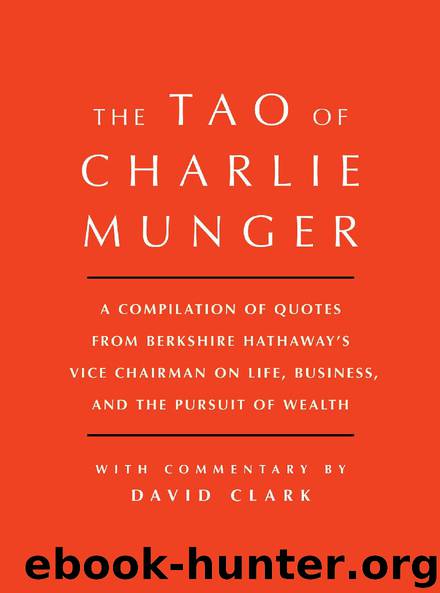The Tao of Charlie Munger by David Clark

Author:David Clark
Language: eng
Format: epub
Publisher: Scribner
# 72
GOING TO EXTREMES
–
“In business we often find that the winning system goes almost ridiculously far in maximizing and or minimizing one or a few variables—like the discount warehouses of Costco.”
–
Costco is obsessed with keeping operating costs to a minimum. It does not provide shopping bags—customers bring their own bags or use an empty packing box the store supplies—saving Costco 2 to 5 cents each on plastic bags and 10 to 25 cents each on paper ones. That might not seem significant, but consider this: Costco does $15 billion in sales a year. If the average customer spends $100 per shopping trip, that means that Costco has approximately 150 million customer checkouts every year. If three paper bags at 10 cents per bag were used per checkout, the total bag cost per checkout of 30 cents, multiplied by 150 million, would cost Costco approximately $45 million a year. By simply by getting rid of paper bags at checkout, Costco arguably saves itself $45 million a year.
GEICO did something that seemed outrageous—early on it got rid of the insurance agent and his commission by selling directly to the consumer—thereby reducing its costs, which allowed it to be more competitive in the pricing of its insurance products and still maintain its profit margins.
Bank of America made the extreme decision to focus in on the individual depositor, who had been sorely neglected by larger banks. As the population base of California grew in size and wealth, Bank of America’s individual depositors also grew in size and wealth. As a result, today Bank of America is one of the largest banks in the nation.
Unlike its competitors, Berkshire Hathaway’s Nebraska Furniture Mart buys huge quantities of furniture from a single manufacturer, at a huge discount, which allows its stores to sell us a sofa cheaper than the competition and still keep its margins high.
The one thing that all of Berkshire’s businesses have in common is that they are managed by people who are willing to go to great lengths to keep costs low. That goes for Berkshire’s home office as well—it doesn’t have a public relations or investor services department, and for many years the annual report was printed on the cheapest paper possible and had no expensive color photos. (Note: In recent years the paper quality has improved and the annual report now sports one color photo—which may be a sign that management is starting to slip.)
Download
This site does not store any files on its server. We only index and link to content provided by other sites. Please contact the content providers to delete copyright contents if any and email us, we'll remove relevant links or contents immediately.
| Analysis & Strategy | Bonds |
| Commodities | Derivatives |
| Futures | Introduction |
| Mutual Funds | Online Trading |
| Options | Portfolio Management |
| Real Estate | Stocks |
Pioneering Portfolio Management by David F. Swensen(5640)
Rich Dad Poor Dad by Robert T. Kiyosaki(5203)
How To Win Friends and Influence People by Dale Carnegie(3816)
The Money Culture by Michael Lewis(3319)
The Dhandho Investor by Mohnish Pabrai(3196)
The Wisdom of Finance by Mihir Desai(3114)
Liar's Poker by Michael Lewis(2841)
The Intelligent Investor by Benjamin Graham Jason Zweig(2613)
The ONE Thing by Gary Keller(2554)
Mastering Bitcoin: Programming the Open Blockchain by Andreas M. Antonopoulos(2537)
Investing For Dummies by Eric Tyson(2489)
How to Day Trade for a Living: Tools, Tactics, Money Management, Discipline and Trading Psychology by Andrew Aziz(2483)
How to Win Friends and Influence People by Dale Carnegie(2472)
Rich Dad Poor Dad: What The Rich Teach Their Kids About Money - That The Poor And Middle Class Do Not! by Robert T. Kiyosaki(2454)
Fooled by Randomness: The Hidden Role of Chance in Life and in the Markets by Nassim Nicholas Taleb(2444)
Zero Hour by Harry S. Dent Jr. & Andrew Pancholi(2263)
Market Wizards by Jack D. Schwager(2186)
Rich Dad's Guide to Investing by Robert T. Kiyosaki(2135)
How to Pay Zero Taxes, 2018 by Jeff A. Schnepper(2125)
